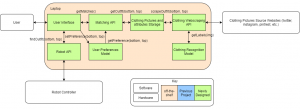This week I worked on:
- fine-tuned detector. It didn’t result in significant increases in accuracy.
- I ran into some overfitting problems with the classifier. The training accuracy would hover around 70% but the testing accuracy was only 30%. I added a batch regularization layer, dropout layer, and better preprocessing. Hopefully by next week I can get a model with good accuracy. If I still can’t get a good model trained, as risk mitigation I can find an existing model online, however it is not ideal as existing models use old architecture so I would not maximize accuracy.
- implemented clothing images and attributes storage. Uses pickle to store images and attributes in a dictionary.
- Implemented color attribution. Uses MMCQ algorithm with color thief API.
For next week:
- Retrain classifier with new model.
- train fine-grained clothing attribution model.
Although I am slightly behind schedule for the models, I am ahead of schedule for the clothing storage, which means I can focus more time onto the models.



